How to play backgammon short video rules. Rules of the game of short backgammon video tutorial
Short backgammon - very difficult, but very interesting game for two players. It requires a special board with 24 cells called points. Special terms are also available to designate groups of cells, as well as certain parts of the playing field.
It is quite difficult to understand all these names and features of each item, especially for a small child. However, if desired, this can be done in a short time. In this article, we bring to your attention the rules of the game of short backgammon for beginners in pictures, with the help of which everyone can master the necessary concepts and understand the course of the competition.
Rules for playing short oriental backgammon
To understand the rules of the game of short backgammon, first you need to familiarize yourself with such a pattern as:

It is with this arrangement of checkers that the course of the game begins. At the same time, on the side of each player, 2 groups of 6 cells each are formed, which are called the house and the yard. These sections are separated from each other by a bar protruding above the playing field, which has the name "bar". Similar groups of cells on the opposite side are respectively called the opponent's house and yard.
All points for each player are numbered from 1 to 24, starting with his own house. In this case, the numbering is carried out in such a way that the last point for one participant is the first point for his opponent. As you can see from the picture, at the beginning of the game, all the checkers of both players are placed on the field so that they have 5 chips in the 6th point, 3 in the 8th, 5 in the 13th and 2 in the 24th.
In the course of the competition, each participant must move their chips in a certain direction. In particular, White should move according to the following pattern:

The owner of the black checkers, accordingly, moves his arsenal in the opposite direction. The goal of each player in the game of short backgammon is to gradually move all his chips to his own home, and then remove them from the board.
At the start of the game, both players roll the dice to determine who goes first. The one who managed to knock out the most points makes the first move and moves his chips by the number of points indicated on the dice, taking into account the following rules:
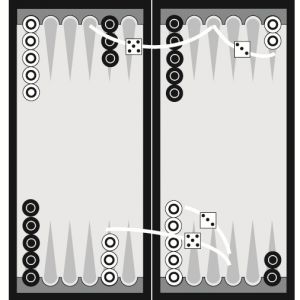
We also invite you to familiarize yourself with short rules games in and
Rules of the game. Short backgammon.
Starting position
Short backgammon is a game for two players on a board consisting of twenty-four narrow triangles called points. The triangles alternate in color and are grouped into four groups of six triangles each. These groups are called - house, yard, house of the enemy, yard of the enemy. The house and the yard are separated from each other by a plank that protrudes above the playing field and is called a bar.
Fig 1. Board with checkers in initial position.
An arrangement that is mirror-symmetrical to that shown in the figure is also possible. The house in it is located on the left, and the courtyard - respectively on the right.
Points are numbered for each player separately, starting from the house of this player. The farthest point is the 24th point, which is also the first point for the opponent. Each player has 15 checkers.
The initial arrangement of checkers is as follows: each of the players has two checkers in the twenty-fourth point, five in the thirteenth, three in the eighth and five in the sixth.
Each player has his own pair of dice and a special glass that is used to mix the dice. The die with the numbers 2, 4, 8, 16, 32, and 64 printed on its faces is used to keep track of the current bet of the game.
Purpose of the game
The goal of the game is to move all your checkers to your home and then remove them from the board.
The first player to remove all of their checkers wins the game.
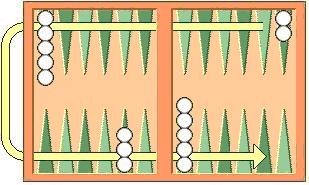
Fig 2. Direction of movement of white checkers. The red checkers move in the opposite direction.
Checkers movement
To start the game, each player rolls one die. This determines which player goes first and which numbers he uses for his first move. If both players have the same number rolled, they both roll the dice until they roll various meanings. The player who rolled the higher number moves his checkers according to the numbers on both dice. After the first move, the players take turns throwing two dice and making moves.
The numbers on each die indicate how many points, or pips, the player must move his checkers. Checkers always move in only one direction, from points with higher numbers to points with smaller numbers. The following rules apply:
1. A checker can only move to an open point, that is, one that is not occupied by two or more checkers of the opposite color.
2. The numbers on both dice make up separate moves. For example, if a player has 5 and 3, he can move one checker to three fields, and the other to five, or he can move one checker to eight (five plus three) fields at once, but the last one only if the intermediate point (three or five fields away from the starting point) is also open.
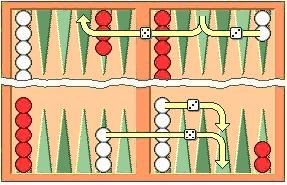
Rice. 3. Two ways White can play 5:3.
3. The player who has a double plays each of the numbers on each of the dice twice. For example, if 6-6 is rolled, then the player must make four moves of six points, and he can move the checkers in any combination as he sees fit.
4. The player must use both numbers that he has dropped out, if they are allowed by the rules (or all four numbers, if he has a double).
When only one number can be played, the player must play that number.
If each of the numbers is playable individually (but not both together), the player must play the higher number. If a player cannot make a move, then he skips a move. In case of a double, if the player cannot use all four numbers, he must play as many moves as possible.
How to beat and charge a checker.
A point occupied by only one checker is called a blot. If a checker of the opposite color stops at this point, the blot is considered beaten and is placed on the bar. At any time when one or more checkers are on the bar, the player's first duty is to load the checkers in the opponent's home. The checker enters the game by moving to the point corresponding to the discarded value of the die.
For example, if a player has rolled 4 and 6, he can charge a checker to the fourth or sixth points, if they are not occupied by two or more opponent's checkers.
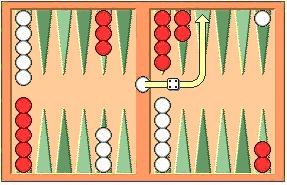
Fig 4. If White rolled 6:4, but one of the checkers is on the bar, they must load the checker into point 4 in the red house, since point 6 is occupied by red.
If both points corresponding to the values of the rolled dice are occupied, the player skips his turn. If a player can bring in some of his checkers but not all of them, he must charge all the checkers he can and then skip the remainder of his turn. Once all the checkers have been entered from the bar, the unused dice values can be used as usual by moving the checker you loaded or any other checker.
How to throw away checkers
When a player has brought all his fifteen checkers to his home, he can start throwing them off the board. The player throws a checker as follows: A pair of dice is thrown, and the checkers that are on the points corresponding to the rolled values are removed from the board. For example, if 6 points fell out, you can remove the checker from the sixth point.
If there is not a single checker on the point corresponding to the dropped die, the player is allowed to move the checker from points greater than the dropped number. If a player can make any moves, he is not obliged to remove a checker from the board.
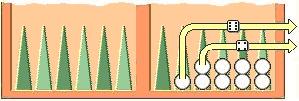
Fig 5. White rolled 6:4. They throw out two checkers.
In the stage of throwing out the checkers, all the checkers of the player must be in his home. If a checker is beaten in the process of dropping checkers, then the player must bring the checker back to his home before he continues to drop checkers. The first player to remove all checkers from the board wins the game.
Dave
Backgammon is usually played for money with an agreed bet per point won. Each game starts with a bet of one point. During the game, a player who feels that he has a fairly large advantage in the game may offer to dave (i.e., double the stakes). He can only do this before the start of his turn, before he rolls the dice.
If the player who was offered to double the bets folds, then he surrenders this game and loses one point. Otherwise, he must call dave and play double. The player who accepted the dave becomes the owner of the cube, and only he can now double the bets again. The counter doubling of rates in the same game is called bass (or redubl). If the player gives up at this point, he loses as many points as were at stake before this redouble. Otherwise, the cube passes to him, and the game continues on with twice the value of the stakes. There is no limit on the number of redables.
Mars and Cox
At the end of the game, if the losing player managed to remove at least one checker from the board, he loses as many points as he is worth on the die by that moment (one point if none of the players said yes). However, if the loser did not have time to throw a single checker off the board, he loses the mars and loses twice the number of points. If, moreover, the loser has not removed a single checker and one or more of his checkers remain on the bar or in the opponent's house, he loses the coke and loses three times the number of points.
Additional rules
Some additional rules have become widespread in the game.
1. Auto-double If both players get the same number of points on the first move, then the bets are doubled. The cube is rotated in twos and remains in the middle of the board. Players usually agree in advance to limit the number of auto redoubles at the beginning of the game. This rule is occasionally used when playing for money to give more excitement.
2. Beaver. If a player is declared a dove, he can immediately double the stakes by announcing an oncoming redouble - beaver, in this case the die remains with this player. The player who first declared the dave has the option of accepting the bisever or passing, as in the case of a simple dave.
3. Jacobi's rule. Mars and coke are counted as one point if neither player has declared dave during the course of the game. This rule speeds up the game because it eliminates situations where the player doesn't call dove because they want to play mars.
Matches, moneygame and backgammon team game
· As a rule, a match consists of several parties. The goal of the whole match is to score a certain number of points (usually played up to 3, 5, or more odd number of points)
· In matches, dave is usually used.
· There is one limitation to the previous paragraph. (Crawford's rule). If in a given set your opponent scored one point less than what is necessary to win the match, then you do not have the right to declare dave directly in this set. If you win a game, you can already double your bets in the next one.
· There is a variant of the game of short backgammon moneygame, as the name suggests, it is usually played for money. In this variant, the number of parties is not limited (usually they play up to a certain difference in the score or until a certain time).
· In moneygame, Jacobi's rule usually applies - that is, until a die is shown, mars and coke count as 1 point. Beaver can also be used in moneygame, if the parties have agreed on this before the start of the game.
At tournaments and in clubs, sometimes several various options team game of backgammon. The main options are:
1. Pair consultations - A two-on-two game on the same board. The game is on according to the usual rules, but on each side there are two players who are allowed to consult with each other. Bones, as a rule, are thrown all the time by one of the players, or they change after each game.
2. Team tournament - As a rule, each team consists of three players. The game is played according to the usual rules on three boards. A team needs to win two out of three matches to win.
3. Shvets (chouette) - Club variant of backgammon game "One against all".
Controversial situations
1. Both dice must be thrown at the same time on the flat surface of the board in the right section. The player must repeat the throw if one or both dice are outside the right section of the board, hit the checkers or do not lie horizontally.
2. A move is considered made when the player has taken his dice. If the move at the same time turned out to be incomplete or contrary to the rules, the opponent has the opportunity to accept the move in the form in which it was made, or to require the player to make the correct move. The move is considered to be made as it is, if the opponent rolled his dice or started his move by declaring dove.
3. If a player throws the dice before his opponent has completed his turn (that is, he has not yet taken his dice), the player's throw does not count. This rule is usually not used if the move was forced or when further contact between the checkers of opposite sides is not possible.
Starting position
Short backgammon is a game for two players on a board consisting of twenty-four narrow triangles called points. The triangles alternate in color and are grouped into four groups of six triangles each. These groups are called - house, yard, house of the enemy, yard of the enemy. The house and the yard are separated from each other by a plank that protrudes above the playing field and is called a bar.
Rice. 1 Board with checkers in initial position.
An arrangement that is mirror-symmetrical to that shown in the figure is also possible. The house in it is located on the left, and the courtyard - respectively on the right.
Points are numbered for each player separately, starting from the house of this player. The farthest point is the 24th point, which is also the first point for the opponent. Each player has 15 checkers. The initial arrangement of checkers is as follows: each of the players has two checkers in the twenty-fourth point, five in the thirteenth, three in the eighth and five in the sixth.
Each player has his own pair of dice and a special glass that is used to mix the dice. The die with the numbers 2, 4, 8, 16, 32, and 64 printed on its faces is used to keep track of the current bet of the game.
Purpose of the game
The goal of the game is to move all your checkers to your home and then remove them from the board. The first player to remove all of their checkers wins the game.
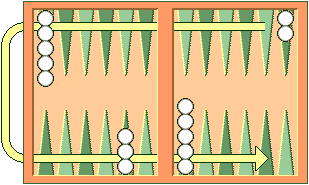
Fig 2. Direction of movement of white checkers. The red checkers move in the opposite direction.
Checkers movement
To start the game, each player rolls one die. This determines which player goes first and which numbers he uses for his first move. If both players have the same numbers, they both roll the dice until different values are rolled. The player who rolled the higher number moves his checkers according to the numbers on both dice. After the first move, the players take turns throwing two dice and making moves.
The number on each die shows how many points, or pips, the player must move his checkers. Checkers always move in only one direction, from points with higher numbers to points with smaller numbers. The following rules apply:
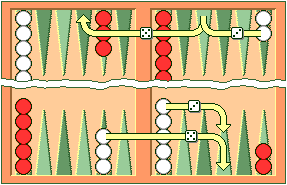
How to beat and charge a checker.
A point occupied by only one checker is called blot. If a checker of the opposite color stops at this point, the blot is considered beaten and put on bar. At any time when one or more checkers are on the bar, the player's first duty is to charge checkers in the opponent's house. The checker enters the game by moving to the point corresponding to the discarded value of the die.
For example, if a player has rolled 4 and 6, he can charge a checker to the fourth or sixth points, if they are not occupied by two or more opponent's checkers.
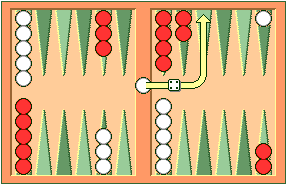
Fig 4. If White has dropped but one of the checkers on the bar, they must charge a checker to point 4 in Red's home, since point 6 is occupied by Red.
If both points corresponding to the values of the rolled dice are occupied, the player skips his turn. If a player can bring in some of his checkers, but not all, he must charge all the checkers he can and then skip the rest of the move. that you have loaded, or any other checker.
How to throw away checkers
When a player has brought all his fifteen checkers to his home, he may start throwing away them from the board. The player throws a checker as follows: A pair of dice is thrown, and the checkers that are on the points corresponding to the rolled values are removed from the board. For example, if 6 points fell out, you can remove the checker from the sixth point.
If there is not a single checker on the point corresponding to the dropped die, the player is allowed to move the checker from points greater than the dropped number. If a player can make any moves, he is not obliged to throw a checker off the board.
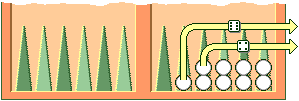
Fig. 5. White dropped out They throw out two checkers.
In the stage of throwing out the checkers, all the checkers of the player must be in his home. If a checker is beaten in the process of dropping checkers, then the player must bring the checker back to his home before he continues to drop checkers. The first player to remove all checkers from the board wins the game.
Dave
Backgammon is usually played for money with an agreed bet per point won. Each game starts with a bet of one point. During the game, a player who feels that he has a fairly large advantage in the game may offer to dave (i.e., double the stakes). He can only do this before the start of his turn, before he rolls the dice.
If the player who was offered to double the stakes, passes, then he surrenders this game and loses one point. Otherwise, he must accept give and play with double stakes. The player who accepted the dave becomes the owner of the cube, and only he can now double the stakes again. The counter doubling of bets in the same game is called bass(or redubl). If the player gives up at this point, he loses as many points as were at stake before this redouble. Otherwise, the cube passes to him, and the game continues on with twice the value of the stakes. There is no limit on the number of redables.
Mars and Cox
At the end of the game, if the losing player managed to remove at least one checker from the board, he loses as many points as he is worth on the die by that moment (one point if none of the players said yes). However, if the loser did not have time to throw a single checker off the board, he loses Mars and loses double number of points. If, moreover, the loser has not removed a single checker and one or more of his checkers remain on the bar or in the opponent's house, he loses coke and loses tripled number of points.
Additional rules
Some additional rules have become widespread in the game.
- Auto-double If both players get the same number of points on the first move, then the bets are doubled. The cube is rotated in twos and remains in the middle of the board. Players usually agree in advance to limit the number of auto redoubles at the beginning of the game. This rule is occasionally used when playing for money to give more excitement.
- Beaver. If a player is declared a dove, he can immediately double the stakes by announcing an oncoming redouble - beaver, in this case the die remains with this player. The player who first called the dave has the option of accepting that bisever or passing, as in the case of a simple dave.
- Jacobi rule. Mars and coke are counted as one point if neither player has declared dave during the course of the game. This rule speeds up the game because it eliminates situations where the player doesn't call dove because they want to play mars.
Matches, moneygame and backgammon team game
- As a rule, a match consists of several games. The goal of the whole match is to score a certain number of points (usually played up to 3, 5, or more odd number of points)
- In matches, as a rule, dave is used.
- There is one restriction to the previous point. (Rule Crawford). If in a given set your opponent scored one point less than what is necessary to win the match, then you do not have the right to declare dave directly in this set. If you win a game, you can already double your bets in the next one.
- There is a variant of playing short backgammon money game, as the name suggests, it is usually played for money. In this variant, the number of parties is not limited (usually they play up to a certain difference in the score or until a certain time).
- In moneygame, the rule usually applies Jacobi- that is, until a die is shown, mars and coke count as 1 point. Beaver can also be used in moneygame, if the parties have agreed on this before the start of the game.
- At tournaments and in clubs, sometimes several different variants of a team game of backgammon are used. The main options are:
- Pair consultations - A two-on-two game on the same board. The game is played according to the usual rules, but there are two players on each side who are allowed to consult with each other. Bones, as a rule, are thrown all the time by one of the players, or they change after each game.
- Team tournament - As a rule, each team consists of three players. The game is played according to the usual rules on three boards. A team needs to win two out of three matches to win.
- Shvets (chouette) - Club version of backgammon "One against all".
Controversial situations
- Both dice must be thrown at the same time on the flat surface of the board in the right section. The player must repeat the throw if one or both dice are outside the right section of the board, hit the checkers or do not lie horizontally.
- A move is considered made when the player has taken his dice. If the move at the same time turned out to be incomplete or contrary to the rules, the opponent has the opportunity to accept the move in the form in which it was made, or to require the player to make the correct move. The move is considered to be made as it is, if the opponent rolled his dice or started his move by declaring dove.
- If a player rolls the dice before his opponent has completed his turn (i.e., has not taken his dice yet), the player's roll does not count. This rule is usually not used if the move was forced or when further contact between the checkers of opposite sides is not possible.
Rules of the game "Short Backgammon"
Starting position
A game for two players on a board of 24 narrow triangles called points.
The triangles are grouped into four groups of six triangles each. These groups are called - house, yard, house of the enemy, yard of the enemy. The house and the yard are separated from each other by a plank that protrudes above the playing field and is called a bar.
Purpose of the game
The goal of the game "" is to bring all your chips to the "house" and remove them from the board before the second player does.
Chip movement
To start the game, each player rolls one die. This determines which player goes first and which numbers he uses for his first move. If both players have the same numbers, they both roll the dice until different values are rolled. The player with the higher number moves their chips according to the numbers on both dice. After the first move, the players take turns throwing two dice and making moves.
The number on each dice indicates how many points the player must move his pieces. Chips always move only in the direction of their home. In this case, the rule applies: a chip can only move to an open point, that is, to one that is not occupied by two or more chips of the opposite color.
The numbers on both dice make up separate moves. For example, if a player has rolled 5 and 3, he can go with one chip to three fields, and the other - to five, or he can go with one chip to eight (5 + 3) fields at once, but the last ones only if the intermediate point (three or five fields away from the starting point) is also open.
The player who rolled the double plays each of the numbers on each of the dice twice.
For example, if the roll is 6-6, then the player must make four moves of six points, and he can move the pieces in any combination he sees fit.
The player must use both numbers he has drawn if they are allowed by the rules (or all four numbers if he has a double). When only one number can be played, the player must play that number. If each of the numbers is playable individually (but not both together), the player must play the higher number. If a player cannot make a move, then he skips a move. In case of a double, if the player cannot use all four numbers, he must play as many moves as possible.
How to score and charge a chip
A point occupied by only one chip is called a blot. If a chip of the opposite color stops at this point, the blot is considered beaten and is placed on the bar. At any time when one or more chips are on the bar, the player's first duty is to charge the chips at the opponent's home. The token comes into play by moving to the point corresponding to the value of the rolled die.
For example, if a player rolls a 4 and a 6, he can charge the chip into the fourth. or to the sixth points, if they are not occupied by two or more opponent's pieces.
If both points corresponding to the values of the rolled dice are occupied, the player skips his turn.
How to reset chips
When a player has brought all of his fifteen pieces to his home, he can start throwing them off the board. The player throws a piece as follows: a pair of dice is rolled, and the pieces that are on the points corresponding to the rolled values are removed from the board. For example, if 6 points fell out, you can remove the chip from the sixth point.
If there is not a single chip on the point corresponding to the rolled die, the player is allowed to move the chip from points greater than the rolled number. If a player can make any moves, he is not required to remove a piece from the board.
In the stage of discarding chips, all the player's chips must be in his home. If a chip is hit while the chip is being discarded, the player must bring the chip back to his home before he continues to discard the tiles. The one who first removed all the chips from the board wins the game.
A game for two players, on a board consisting of twenty-four narrow triangles called
points. The triangles alternate in color and are grouped into four groups of six triangles each.
These groups are called - house, yard, house of the enemy, yard of the enemy. The house and yard are separated by a plank, which
stands above the playing field and is called bar.
Points are numbered for each player separately, starting from the house of this player. The farthest point is the 24th point, which is also the first point for the opponent. Each player has 15 checkers. The initial arrangement of checkers is as follows: each of the players has two checkers in the twenty-fourth point, five in the thirteenth, three in the eighth and five in the sixth.
Each player has his own pair of dice and a special glass that is used to mix the dice. cube with the numbers 2, 4, 8, 16, 32, and 64 printed on its edges is used to keep track of the current bet of the game.
The purpose of the game is short backgammon
The goal of the game is to move all your checkers to your home and then remove them from the board. The first player to remove all of their checkers wins the game.Movement checkers game short backgammon
To start the game, each player rolls one die. This determines which player goes first and which numbers he uses for his first move. If both players have the same numbers, they both roll the dice until different values are rolled. The player who rolled the higher number moves his checkers according to the numbers on both dice. After the first move, the players take turns throwing two dice and making moves.The number on each die shows how many points, or pips, the player must move his checkers. Checkers always move in only one direction, from points with higher numbers to points with smaller numbers. The following rules apply:
How to beat and charge a checker
A point occupied by only one checker is called blot. If a checker of the opposite color stops at this point, the blot is considered beaten and put on bar. At any time when one or more checkers are on the bar, the player's first duty is to charge checkers in the opponent's house. The checker enters the game by moving to the point corresponding to the discarded value of the die.For example, if a player has rolled 4 and 6, he can charge a checker to the fourth or sixth points, if they are not occupied by two or more opponent's checkers.
If both points corresponding to the values of the rolled dice are occupied, the player skips his turn. If a player can bring in some of his checkers but not all of them, he must charge all the checkers he can and then skip the remainder of his turn. Once all the checkers have been entered from the bar, the unused dice values can be used as usual by moving the checker you loaded or any other checker.
How to throw away checkers
When a player has brought all his fifteen checkers to his home, he may start throwing away them from the board. The player throws a checker as follows: A pair of dice is thrown, and the checkers that are on the points corresponding to the rolled values are removed from the board. For example, if 6 points fell out, you can remove the checker from the sixth point.If there is not a single checker on the point corresponding to the dropped die, the player is allowed to move the checker from points greater than the dropped number. If a player can make any moves, he is not obliged to remove a checker from the board.
